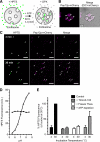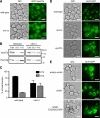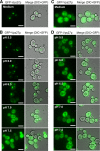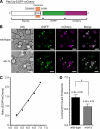The endosomal Na(+)/H(+) exchanger contributes to multivesicular body formation by regulating the recruitment of ESCRT-0 Vps27p to the endosomal membrane
- PMID: 21896492
- PMCID: PMC3199507
- DOI: 10.1074/jbc.M111.260612
The endosomal Na(+)/H(+) exchanger contributes to multivesicular body formation by regulating the recruitment of ESCRT-0 Vps27p to the endosomal membrane
Abstract
Multivesicular bodies (MVBs) are late endosomal compartments containing luminal vesicles (MVB vesicles) that are formed by inward budding of the endosomal membrane. In budding yeast, MVBs are an important cellular mechanism for the transport of membrane proteins to the vacuolar lumen. This process requires a class E subset of vacuolar protein sorting (VPS) genes. VPS44 (allelic to NHX1) encodes an endosome-localized Na(+)/H(+) exchanger. The function of the VPS44 exchanger in the context of vacuolar protein transport is largely unknown. Using a cell-free MVB formation assay system, we demonstrated that Nhx1p is required for the efficient formation of MVB vesicles in the late endosome. The recruitment of Vps27p, a class E Vps protein, to the endosomal membrane was dependent on Nhx1p activity and was enhanced by an acidic pH at the endosomal surface. Taken together, we propose that Nhx1p contributes to MVB formation by the recruitment of Vps27p to the endosomal membrane, possibly through Nhx1p antiporter activity.
Figures









Similar articles
-
Endosomal Na+ (K+)/H+ exchanger Nhx1/Vps44 functions independently and downstream of multivesicular body formation.J Biol Chem. 2011 Dec 23;286(51):44067-44077. doi: 10.1074/jbc.M111.282319. Epub 2011 Oct 13. J Biol Chem. 2011. PMID: 21998311 Free PMC article.
-
Distinct mechanisms enable inward or outward budding from late endosomes/multivesicular bodies.Exp Cell Res. 2018 Nov 1;372(1):1-15. doi: 10.1016/j.yexcr.2018.08.027. Epub 2018 Aug 23. Exp Cell Res. 2018. PMID: 30144444 Free PMC article.
-
The yeast vps class E mutants: the beginning of the molecular genetic analysis of multivesicular body biogenesis.Mol Biol Cell. 2010 Dec;21(23):4057-60. doi: 10.1091/mbc.E09-07-0603. Mol Biol Cell. 2010. PMID: 21115849 Free PMC article.
-
The regulation of Endosomal Sorting Complex Required for Transport and accessory proteins in multivesicular body sorting and enveloped viral budding - An overview.Int J Biol Macromol. 2019 Apr 15;127:1-11. doi: 10.1016/j.ijbiomac.2019.01.015. Epub 2019 Jan 4. Int J Biol Macromol. 2019. PMID: 30615963 Review.
-
ESCRT and Membrane Protein Ubiquitination.Prog Mol Subcell Biol. 2018;57:107-135. doi: 10.1007/978-3-319-96704-2_4. Prog Mol Subcell Biol. 2018. PMID: 30097773 Review.
Cited by
-
Endosomal Na+ (K+)/H+ exchanger Nhx1/Vps44 functions independently and downstream of multivesicular body formation.J Biol Chem. 2011 Dec 23;286(51):44067-44077. doi: 10.1074/jbc.M111.282319. Epub 2011 Oct 13. J Biol Chem. 2011. PMID: 21998311 Free PMC article.
-
A novel AtKEA gene family, homolog of bacterial K+/H+ antiporters, plays potential roles in K+ homeostasis and osmotic adjustment in Arabidopsis.PLoS One. 2013 Nov 20;8(11):e81463. doi: 10.1371/journal.pone.0081463. eCollection 2013. PLoS One. 2013. PMID: 24278440 Free PMC article.
-
ESCRT-0 protein hepatocyte growth factor-regulated tyrosine kinase substrate (Hrs) is targeted to endosomes independently of signal-transducing adaptor molecule (STAM) and the complex formation with STAM promotes its endosomal dissociation.J Biol Chem. 2014 Nov 28;289(48):33296-310. doi: 10.1074/jbc.M114.578245. Epub 2014 Oct 8. J Biol Chem. 2014. PMID: 25296754 Free PMC article.
-
Hepatitis C Virus Proteins Interact with the Endosomal Sorting Complex Required for Transport (ESCRT) Machinery via Ubiquitination To Facilitate Viral Envelopment.mBio. 2016 Nov 1;7(6):e01456-16. doi: 10.1128/mBio.01456-16. mBio. 2016. PMID: 27803188 Free PMC article.
-
GsCHX19.3, a member of cation/H+ exchanger superfamily from wild soybean contributes to high salinity and carbonate alkaline tolerance.Sci Rep. 2017 Aug 25;7(1):9423. doi: 10.1038/s41598-017-09772-3. Sci Rep. 2017. PMID: 28842677 Free PMC article.
References
-
- Lee J. A., Beigneux A., Ahmad S. T., Young S. G., Gao F. B. (2007) Curr. Biol. 17, 1561–1567 - PubMed
-
- Katzmann D. J., Odorizzi G., Emr S. D. (2002) Nat. Rev. Mol. Cell Biol. 3, 893–905 - PubMed
-
- Raiborg C., Stenmark H. (2009) Nature 458, 445–452 - PubMed
-
- Carlton J. G., Martin-Serrano J. (2007) Science 316, 1908–1912 - PubMed
Publication types
MeSH terms
Substances
LinkOut - more resources
Full Text Sources
Molecular Biology Databases

